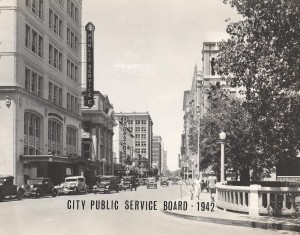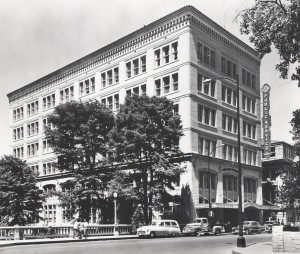
 by Tracy Idell Hamilton
by Tracy Idell Hamilton
In 1942, the city of San Antonio made a $34 million bet to buy the local utility – one that has paid off to the tune of more than $5 billion so far.
More than 50 years later, the city made another crucial calculation, to hang on to CPS Energy in the face of a deregulated energy market. That decision, too, has paid off for city and ratepayers, who continue to enjoy some of the lowest rates in Texas.
First, the bet: at the time, the San Antonio Public Service Company, known as Sapsco, ran the city’s power plants, gas network, and streetcar lines. Sapsco was owned by American Light and Traction Co. through the 1920s and 1930s, but antitrust laws forced the company to divest its utility holdings across the country.
The Lower Colorado River Authority approached then-Mayor C.K. Quinn about breaking up the utility; LCRA would buy the power plants, while the city would purchase the distribution network — the lines and poles.
Quinn was amenable to the idea, according to CPS Energy’s de facto historian Joe Fulton, who worked for the utility for 34 years. But a local entrepreneur, Ralph Morrison, approached the mayor and City Commissioners with a better idea: buy it all.
City leaders ultimately saw the wisdom in San Antonio controlling its own power, and made a bid to buy the company. But the LCRA and the Blanco-Guadalupe River Authority fought back. Lawsuits “came thick and fast,” according to an Oct. 20, 1942 article in the San Antonio Express, and it looked for a time like there would be no deal.
But on Oct. 24, 1942, the last day possible, the city of San Antonio prevailed. It issued $33.9 million in bonds to purchase Sapsco. As part of the deal, the city had to sell a plant on the Comal River to the GBRA. It also sold off the streetcar division of the company.
Also as part of the deal, the new company, known as the City Public Service Board, would return up to 14 percent of revenue to the city of San Antonio as the return on its investment. That money would go into the general fund, where it’s used to fund police and firefighters, roads, drainage and other core city services.
Since 1942, CPS Energy has returned more than $5 billion to its owners, the people of San Antonio. Today that money — roughly $250 million annually — is the city’s largest single revenue stream, and makes up almost one-third of the city’s general fund budget.
In the mid-1990s, however, big changes to the industry were looming. States across the country were deregulating their energy markets; city and CPS Energy officials knew Texas wouldn’t be far behind.
The state Legislature tried to deregulate in 1997, but couldn’t come to an agreement that pleased either privately owned or municipally owned utilities, Fulton said.
“But we saw the writing on the wall,” he said, and CPS Energy began preparing to enter a competitive market, if necessary. That would mean the end of tax-exempt financing, and the need to separate transmission and generation into separate companies. CPS Energy officials also worked “to get leaner and meaner,” said Fulton, reducing staff and updating business practices.
Also in 1997, the City Council conducted a review into whether selling CPS Energy to a private company, paying off the debt and putting the remainder in a trust would be a wise course of action, according to a 1999 story in the San Antonio Express-News.
The study found the city would have to get $16 billion for the utility to “reap the same benefits under the current structure.” The last utility to fetch that kind of price, the story went on, was four times the size of CPS Energy.
The city chose to hang on to its utility.
CPS Energy customers still have some of the lowest rates in the state, and the city is able to pay for vital, basic services with the continuing return on the investment it made in 1942.
“That is a humungous return,” said Fulton. “That’s how important this company is.”
Watch CPS Energy’s 70th anniversary video, featuring an interview with Joe Fulton.
